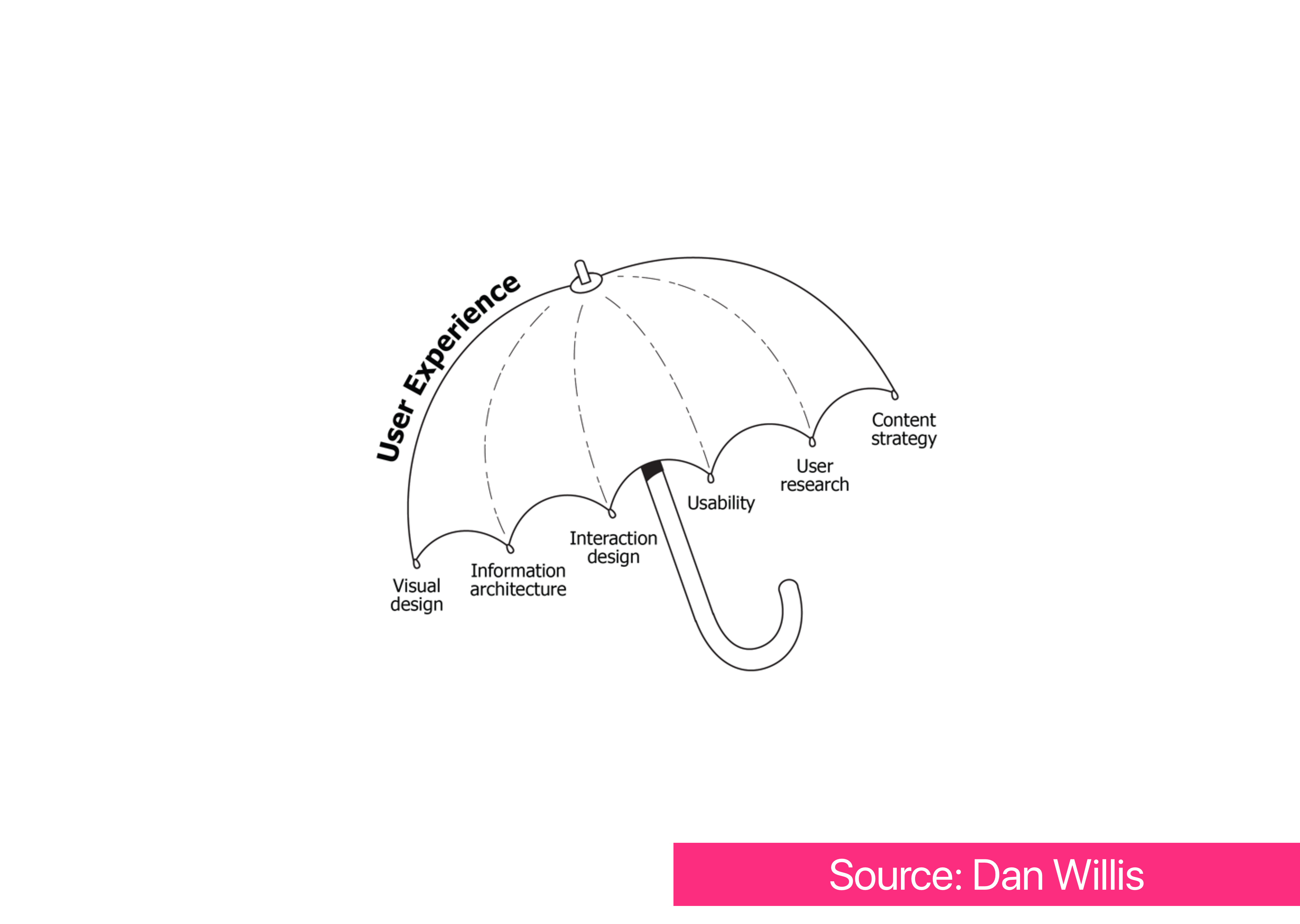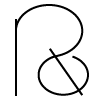Earlier this week, I was invited by a colleague to deliver a lightning talk to human-computer interaction master’s students at City University, on my background as a user experience (UX) designer.
If I am asked to deliver a talk on UX, I always like to start with a very brief overview of what UX actually is by using this really clear visual from Dan Willis. The reason I start with this is to cater for anyone attending the talk who does not fully understand what a UX designer does or has never even heard of the profession before. It helps bring people to a basic understanding quite quickly.

The visual helps to illustrate that UX designers do more than the classic misconception of ‘making things look pretty’. As can be seen, we have a range of skills that a project may or may not require from us depending on the deliverables. Some of our skills may be stronger in comparison to others such as, user research or visual design. If we want to keep developing and evolving as UX designers, we should be constantly refining these skills.
With such a short time slot to fill, I had previously asked what topics they would like me to talk about.

The key ones that emerged were:
- Design process
- Design tools
- Relationships with developers
- User testing
Design Process
With this topic, I focused on the most crucial part of any project which is, user research.
Why is it so important?
If research is not carried out, you are setting your product up to be less successful than if you had completed it. This is because without research:
- You cannot properly understand who your users are
- You do not know how users currently interact with products
- You do not understand why users do what they do
- You do not clearly know if what users say they do, is what they actually do
- You do not know who your competitors are.
The list could go on but hopefully this briefly illustrates the importance of research. In order to design user-centred products, you need to get into the mindset of your users, develop empathy for them, understand their wants, needs and goals, and the way to do that is through research. Once this stage has been completed, we can then move into the ideation phase.
Design Tools
One of the industry standard tools for UI design is called Sketch. It is without doubt one of my favourite tools and I was more than excited to share my experience with it.
Why does it work well?
The app is quite straightforward to learn but the real beauty of it, is how it is enhanced through plugins and symbols. Some of them can speed up workflows and efficiency, helping designers to produce screen-based designs in next to no time. Others for example, enable designers to view their designs as a visually-impaired user – which helps in terms of keeping accessibility at the forefront of a project. On top of that, people can create their own plugins (provided they know how to code). I could keep writing about Sketch because it is a tool that I enjoy using daily and I have watched how it has developed over the years with new functionality continually added.
After creating those beautiful static screens, how do you make them come to life?
As I mentioned, Sketch is enhanced through plugins so it is no surprise that a plugin called Craft can export designs to another tool called InVision where you can add basic clickable transitions, enabling designers to prototype and test their designs.
InVision is another industry standard tool that a lot of UX designers use. They have publicly announced development for a new tool called InVision Studio which will undoubtedly be a competitor to Sketch. It works well for its ease of use and ability to produce clickable prototypes which can even be demoed on a smartphone.
The third and final piece of knowledge that I shared about design tools was on icon fonts. They have worked wonders for me especially when using the symbols override feature in Sketch. An icon font is exactly what it says it is. It is a font that is comprised of icons. When working with developers it is even easier because fewer assets are required containing all of the icons as opposed to having multiple png/svg files.
Relationships with Developers
Great, you have designed this amazing user interface (UI), the UX works like a charm, early user testing has shown positive results and your stakeholders are excited.
What could go wrong?
Well… you need to actually be able to build the thing right?
Further discussions with your development team leaves the room with a stunned silence. It turns out, with the technology stack or UI framework they are using, all of those beautiful custom components cannot be built in the time available. Oh. Dear.
This example is not uncommon, time and time again it crops up where teams work in silos with a lack of sufficient communication. To prevent something like this happening, or at least reduce the risk of this happening, having frequent meetings, regular stand-up sessions, a decision log, minutes from meetings and retrospectives with your developers, can help both designers and developers be better aligned and working towards the same goal. Designers do not necessarily need to know how to code (although it can help if they do know how to), however, it is important that they understand the platform that they are designing for.
Why?
If designers are able to understand the platform and technical constraints, they can propose more feasible design solutions. This does not mean to say that they should limit their creativity or ideation process, by all means they should explore as many ideas as possible but just be mindful of what can and can’t be achieved.
Working with developers can be challenging (especially a remote development team that you may never meet), however, that doesn’t necessarily have to be the case. If in doubt when designing something, just remember to ask! The most important thing here in ensuring a good relationship, is clear communication.
User Testing
Undoubtedly another essential part of the design process because you need to validate your ideas with real users. User testing could be done on something small such as, the colour or placement of a button, or on something bigger such as, a layout change and complete redesign. Testing with real users is essential for iterating designs and ensuring user goals are being fulfilled as opposed to being hindered.
Recruiting the right participants for a user test is equally important because they have to be representational of the intended target market.
For remote user testing, we have found in our team that Lookback works well because we are able to capture video and audio as well as, on-screen clicks. The software also caters for mobile devices. User testing is a great way of making decisions based on actual evidence from users.
On Reflection
I was fortunate enough to be granted permission by my previous team to share some of the work that I had completed despite the product not being launched. This meant that when I was delivering the talk, being able to use concrete examples instead of hypothetical or theoretical examples, made it more useful for the students to relate to.
My main aim of the talk was to share my experience as a UX designer working at a large corporate but to also show that there are more ways, tools and opportunities out there for people to develop their skills and broaden their experiences such as, skills-based volunteering, social innovation challenges, side projects, hackathons and so much more.
